Abstract
The best strategies for haploidentical stem cell transplants are not known. we used a standard myeloablative pretransplant conditioning regimen (30 mg/kg vp-16, 120 mg/kg cyclophosphamide, and 12 gy of tbi in six fractions), an increased peripheral stem cell dose of >10 × 106 CD34+ cells/kg, T cell depletion (with CD34+cell selection and CD4/CD8 depletion steps) to <1 × 105 CD3+ cells/kg and cyclosporine post transplant. Ten patients (7M/3F, median age 11 (3–33) years) with high-risk leukemia (AML in 4, MDS in 2, CML in 1 and T-ALL in 3) received a hemopoietic stem cell transplant (HSCT) from a haploidentical father or sibling. The median number of CD34+ cells was 12.9 (9.5–45.7) × 106 cells/kg; median number of CD3+ cells was 0.41 (0.09–1.89) × 105 CD3+ cells/kg. All patients initially achieved 0.5 × 109/l neutrophils at a median 12 (10–21) days. graft failure in two consecutive patients out of four on the original protocol led to a modification adding atg pretransplant and okt3 post transplant. graft failure was observed in one out of six subsequent patients. acute gvhd ⩾grade ii was observed in three patients. three of 10 patients are alive in cr at >24 and >3 (2) months after transplant. Seven patients died: four of transplant related complications and three of relapse. Increased stem cell dose (⩾10 × 106 CD34+ cells/kg) as obtained using currently available technology may not be sufficient to ensure stable engraftment in patients with high-risk leukemia using standard myeloablative conditioning regimens. Bone Marrow Transplantation (2000) 26, 1033–1036.
This is a preview of subscription content, access via your institution
Access options
Subscribe to this journal
Receive 12 print issues and online access
$259.00 per year
only $21.58 per issue
Buy this article
- Purchase on Springer Link
- Instant access to full article PDF
Prices may be subject to local taxes which are calculated during checkout
Similar content being viewed by others
References
Aversa F, Tabilio A, Velardi A et al. Treatment of high-risk acute leukemia with T cell-depleted stem cells from related donors with one fully mismatched HLA haplotype New Engl J Med 1998 339: 1186–1193
Aversa F, Tabilio A, Terenzi A et al. Successful engraftment of T cell-depleted haploidentical ‘three-loci’ incompatible transplants in leukemia patients by addition of recombinant human granulocyte colony-stimulating factor-mobilized peripheral blood progenitor cells to bone marrow inoculum Blood 1994 84: 3948–3955
Aversa F, Terenzi A, Felicini R et al. Mismatched T cell-depleted hematopoietic stem cell transplantation for children with high-risk acute leukemia Bone Marrow Transplant 1998 22: (Suppl. 5) S29–S32
Aversa F, Terenzi A, Tabilio A et al. Addition of PBPCs to the marrow inoculum allows engraftment of mismatched T cell-depleted transplants for acute leukemia Bone Marrow Transplant 1996 17: (Suppl. 2) S58–S61
Peters C, Matthes-Martin S, Fritsch G et al. Transplantation of highly purified peripheral blood CD34+ cells from HLA-mismatched parental donors in 14 children: evaluation of early monitoring of engraftment Leukemia 1999 13: 2070–2078
Handgretinger R, Schumm M, Lang P et al. Transplantation of megadoses of purified haploidentical stem cells Ann NY Acad Sci 1999 872: 351–361
Speiser DE, Hermans J, van Biezen A et al. Haploidentical family member transplants for patients with chronic myeloid leukaemia: a report of the Chronic Leukaemia Working Party of the European Group for Blood and Marrow Transplantation (EBMT) Bone Marrow Transplant 1997 19: 1197–1203
Henslee-Downey PJ, Abhyankar SH, Parrish RS et al. Use of partially mismatched related donors extends access to allogeneic marrow transplant Blood 1997 89: 3864–3872
Szydlo R, Goldman JM, Klein JP et al. Results of allogeneic bone marrow transplants for leukemia using donors other than HLA-identical siblings J Clin Oncol 1997 15: 1767–1777
Henslee Downey PJ, Parrish RS, MacDonald JS et al. Combined in vitro and in vivo T lymphocyte depletion for the control of graft-versus-host disease following haploidentical marrow transplant Transplantation 1996 61: 738–745
Pietryga D, Casper J, Margolis D et al. Bone marrow transplantation using genotypically haploidentical donors Blood 1996 88: S1: 264a
Bacigalupo A, Mordini N, Pitto A et al. Transplantation of HLA-mismatched CD34+ selected cells in patients with advanced malignancies: severe immunodeficiency and related complications Br J Haematol 1997 98: 760–766
Bachar-Lustig E, Rachamim N, Li HW et al. Megadose of T cell-depleted bone marrow overcomes MHC barriers in sublethally irradiated mice Nature Med 1995 1: 1268–1273
Rachamim N, Gan J, Segall H et al. Tolerance induction by ‘megadose’ hematopoietic transplants: donor-type human CD34 stem cells induce potent specific reduction of host anti-donor cytotoxic T lymphocyte precursors in mixed lymphocyte culture Transplantation 1998 65: 1386–1393
Reisner Y, Bachar-Lustig E, Li HW et al. The role of megadose CD34+ progenitor cells in the treatment of leukemia patients without a matched donor and in tolerance induction for organ transplantation Ann NY Acad Sci 1999 872: 336–348
Reisner Y, Martelli MF . Stem cell escalation enables HLA-disparate haematopoietic transplants in leukaemia patients Immunol Today 1999 20: 343–347
Reisner Y, Martelli MF . Bone marrow transplantation across HLA barriers by increasing the number of transplanted cells Immunol Today 1995 16: 437–440
Dreger P, Glass B, Uharek L et al. Allogenic transplantation of mobilized peripheral blood progenitor cells: towards tailored cell therapy Int J Hematol 1997 66: 1–11
Tichelli A, Passweg J, Hoffmann T et al. Repeated peripheral stem cell mobilization in healthy donors: time-dependent changes in mobilization efficiency Br J Haematol 1999 106: 152–158
Patterson J, Prentice HG, Brenner MK et al. Graft rejection following HLA matched T-lymphocyte depleted bone marrow transplantation Br J Haematol 1986 63: 221–230
Author information
Authors and Affiliations
Rights and permissions
About this article
Cite this article
Passweg, J., Kühne, T., Gregor, M. et al. Increased stem cell dose, as obtained using currently available technology, may not be sufficient for engraftment of haploidentical stem cell transplants. Bone Marrow Transplant 26, 1033–1036 (2000). https://doi.org/10.1038/sj.bmt.1702669
Received:
Accepted:
Published:
Issue Date:
DOI: https://doi.org/10.1038/sj.bmt.1702669
Keywords
This article is cited by
-
Immunosuppressive Properties of Mesenchymal Stem Cells
Stem Cell Reviews and Reports (2012)
-
Potential role of mesenchymal stromal cells in pediatric hematopoietic SCT
Bone Marrow Transplantation (2008)
-
Haploidentical hematopoietic cell transplantation
Bone Marrow Transplantation (2008)
-
Use of natural killer cells in hematopoetic stem cell transplantation
Bone Marrow Transplantation (2005)
-
Graft dysfunction and delayed immune reconstitution following haploidentical peripheral blood hematopoietic stem cell transplantation
Bone Marrow Transplantation (2005)



